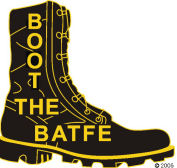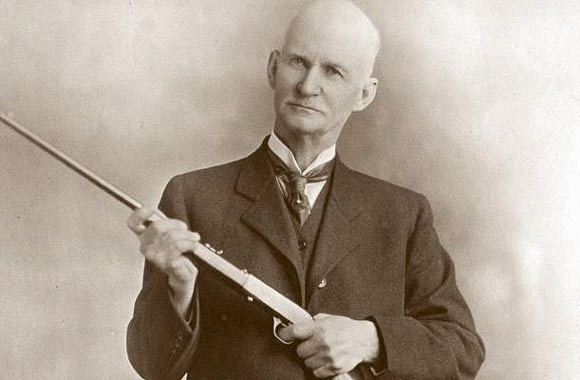

Colt .45 - Still Going Strong after a Century
![]()
By David Stolinsky. August 2nd, 2018
Article Original
John Moses Browning was an inventor. Many consider him a genius. He lived from 1855 to 1926, and during his life he was granted 128 patents. His father Jonathan was a friend of a young lawyer named Abraham Lincoln, who had been an overnight guest in his home. Jonathan was one of the original Mormon settlers of Utah. They left Missouri and Illinois after bloody pogroms in which their leader, Joseph Smith, was lynched, perhaps in part because of his anti-slavery views. On his arrival in Utah, Jonathan established a gunsmith shop in Ogden.
Perhaps these stories of fleeing from persecution convinced young John Browning of the necessity of weapons for defense against criminals and mobs. At the age of 10, John designed his first, crude rifle. His father Jonathan looked at it and complained, “Can’t you make a better gun than that?” John spent the rest of his life answering this question. His father chose John to take over the business, though John was not the eldest son, observing, “You have a good head, John Moses.” He got that right.
Browning had a long association with the Winchester Repeating Arms Company, during which he designed a series of enormously successful lever-action rifles and carbines, including the models of 1886, 1892, 1894, and 1895. Some of these remain in production today, in various parts of the world. How many devices over a century old are still in production - not as antique replicas, but as useful tools? Anyone who ever saw a Western movie saw these rifles, which were noted for their simplicity and durability.
Be not afraid of any man, no matter what his size.
When danger threatens call on me, and I will equalize.
- 19th century ad for Colt revolvers
During World War I, Browning was asked by the War Department to design a machine gun to replace the unreliable foreign weapons then being issued to U.S. troops. This he did. The heavy, water-cooled M1917; its lighter, air-cooled cousin M1919; and the still lighter Browning Automatic Rifle M1918 - the BAR - did yeoman duty in World War I, World War II, and Korea, and even saw some use in Vietnam. The .50 caliber M2 - the “Ma Deuce” or the “Fifty” - is still in use today in Iraq and Afghanistan.
If you saw the TV miniseries “The Pacific” - and if you didn’t you should get it on DVD - you saw Medal of Honor recipient John Basilone heading two machine gun sections of M1917s. If he did not have these reliable, water-cooled weapons, he could not have sustained fire over three days and nights and repelled the Japanese advance on Guadalcanal, for which action he was awarded the Medal. A fellow Marine recalled:
Basilone had a machine gun on the go for three days and nights without sleep, rest, or food. He was in a good emplacement, and causing the Japanese lots of trouble, not only firing his machine gun, but also using his pistol.
And that brings us to what many consider Browning’s crowning achievement, the M1911 semiautomatic pistol, also called the Government Model, or simply “the Forty-five.” In slightly altered form as the M1911A1, it is in use today by our Special Forces, as well as by specialized police units such as the Los Angeles Police Department’s SWAT Team and Special Investigation Section.
While most military and police organizations have adopted newer designs, often made partly of plastic, elite units often choose “Old Slabsides.” What does that tell you about the brilliance of a design that is now 100 years old, yet still surpasses more modern designs in the opinion of those whose lives depend on their equipment?
This is a drawing from Browning’s patent application, which was approved in 1911. The Army adopted the pistol as the Model 1911. As you can see, the patent was applied for in 1910, and the design was based on earlier models. But we count our birthday as when we were born, not when we were conceived, hence “M1911.”
From all this we can learn a great deal:
- Old doesn’t necessarily mean obsolete.
- New doesn’t necessarily mean better.
- Changed doesn’t necessarily mean improved.
- Modern materials aren’t necessarily better than steel.
- If something requires training to use it properly, the answer is to train the users, not to adopt something else that requires less training - but may be inferior.
- Someone who left school at 15 may be more productive than someone who has an advanced degree, but no natural aptitude or practical experience.
- Someone who uses a piece of equipment on a daily basis is better qualified to judge it than an administrator who no longer remembers how to do anything but shuffle papers.
- Someone who uses a piece of equipment on a daily basis is better qualified to judge it than a lawyer who knows only liability, or an accountant who knows only cost.
- Someone with stars on his shoulders is probably a better politician, but he may have less practical knowledge than someone with chevrons on his sleeve.
You might think it odd, or even inappropriate, that a column often devoted to ethical issues should deal with the invention of a lethal weapon. On the contrary, it is entirely appropriate. Recall the quotation that is attributed to both Winston Churchill and George Orwell:
We sleep soundly in our beds because rough men stand ready in the night to visit violence on those who would do us harm.
And recall what firearms authority and retired Marine John D. “Jeff” Cooper taught us:
Unarmed men, and unarmed nations, can only flee from evil. And evil is not overcome by fleeing from it.
On the local level, people who get their news from TV may come to believe that only criminals use guns. But the media systematically ignores the thousands of instances in which armed, law-abiding citizens protect themselves and others against criminals. Those who imagine that a world without guns would be nonviolent should read a bit of history - or watch the film “Braveheart.”
On the international level, we can ask ourselves: Why isn’t Europe still suffering under the Nazi boot? Why isn’t Asia still oppressed by Imperial Japan? It’s because of brave men like John Basilone, who risked and gave their lives to defeat tyranny. But it’s also because of brilliant men like John Moses Browning, who gave them the tools they needed to be victorious.
And today, our Special Forces in Iraq and Afghanistan, as well as elite police units here at home, still arm themselves with Browning’s inventions. We can agree with his father: You indeed had a good head, John Moses. A century later, your inventions are still invaluable tools in the hands of those who choose to fight evil rather than flee from it.
David Stolinsky - www.stolinsky.com.
Contact: dstol@prodigy.net.
![]()



























